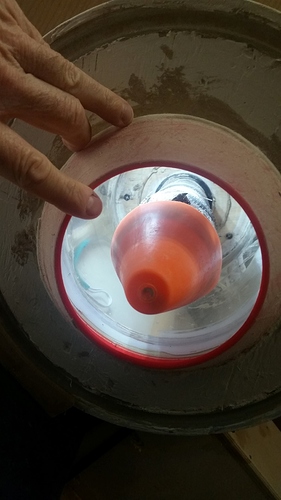This applies more to the SO3 than the Nomad since the SO3 can fill up a shop vac in a relatively short time. However, a smaller version would be helpful for the Nomad also…
Benefits:
- The 5 gallon bucket is very easy to empty
- You can see when the bucket is getting full
- Your vacuum filter will last 50x as long before it needs to be cleaned or replaced
- Its more fun to make chips when you can watch them spin in circles around a translucent bucket

Video of the cyclone in action here https://youtu.be/_v9nCau8m-s
WARNING: A cyclone is very good at removing particles 5 microns and larger which are the ones you can see. Cyclones are terrible at removing particles less than 0.5 microns… and these are the ones that get deep into your lungs and cause long term heart and lung issues over time… So, never use a cyclone without a good (80% or better for 1 micron or smaller particles) filter on your vacuum or dust collector downstream.
If you aren’t familiar with how cyclones work the vacuum cleaner attaches to the top center and pulls air up the center of the clear cylindrical tube. This causes a vacuum vortex to form in the clear cylinder which pulls air in from the hose attached to the side of the cylinder (you sweep up your mess with this hose). The debris enters the cylinder and spins at a high velocity and moves down to the bottom at the same time, emptying the debris into the bucket. The air in the bucket is also spinning which keeps the heavier particle trapped near the outside diameter because of centrifugal forces. The air returns up the center and to the vacuum cleaner through the center tube at the top of the cylinder. Its not exactly intuitive to understand at first but after you see some illustrations on YouTube you can get a good feel for how everything works, if you care to.
I made this cyclone using a 22 quart translucent bucket from Amazon ($12) http://www.amazon.com/Rubbermaid-Commercial-Products-FG572824CLR-Container/dp/B00237S2IU?ie=UTF8&psc=1&redirect=true&ref_=oh_aui_detailpage_o09_s00
The two boards are 3/4" plywood. MDF or anything will work. I just had some ply laying around so that’s what I used. The bottom board has a 7" diameter hole cut in the center and a dado cut around the bottom side that aligns it to the top of the bucket. I spread caulk in the dado and put it on the bucket to form a shape that allows it to seal from the vacuum pressure created when operating (I.E. no latches required if you aren’t going to move it around). My caulk seal was sloppy and could be done much better but it works so I didn’t redo it.
The clear tube is a sheet of 0.070" thick polycarbonate. It inserts into a groove in the grey 3D printed cone shown under it. I solvent bonded them together. The gray rings help the Polycarb tube stay somewhat round but they don’t work very well. I should have used a thinner material for the cyclinder which would have made it MUCH easier to work with. The top wood plate has a 3/8" circular pocket to hold the top of the Polycarbonate round. I expected to have to make changes to this design so I just duct taped everything together. However, it works so well i’ll probably just leave it alone and focus on more important things.
The red vacuum port at the center top is a 3D printed part that includes air straightening vanes inside to help reduce pressure losses. Its also a " bell" shape which may or may not make it more effective.
The piece that mounts the vacuum hose to the side of the Polycarbonate cylinder is another 3D printed part but it wasn’t very strong and didn’t transition well so I ended up using a LOT of duct tape there. I think a 3D milled assembly would work much better there. Feel free to post better designs here. I encourage collaboration to make these designs better for all of us.
.STL files attached CYCLONE SYSTEM STL FILES.zip (1.2 MB)
I suggest NOT using the Inlet Port design and use 0.030" thick PETG for the vertical clear tube. The “Tube Ring” is designed so that two of them can be printed at once.

